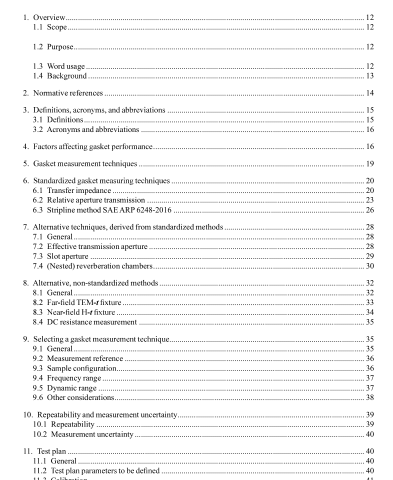IEEE 1302-2019 pdf download.IEEE Guide for the Electromagnetic Characterization of Conductive Gaskets in the Frequency Range of DC to 40 GHz
4. Factors affecting gasket performance Figure 1 ilustrates a typical application where the EMI gasket is placed underneath the lip ofa cover to close the gap between it and the base enclosure. Other similar applications are under connector shells, waveguide flanges, filter cans and meter flanges, and in seams. The objective of the gasket is to provide an electrical path across the gap in the shield such that the impedance of the path through the gasket approaches that of a comparable span of the base shield.
The impedance of the gasket is a function of its materials and construction, its geometry, and the interface between it and the shield. All gasket materials have resistive, inductive, and capacitive properties that may exhibit themselves over different portions of the frequency band. The property, which determines the gasket’s predominant characteristic, depends on the materials and construction of the gasket as well as the geometry of the joint.
Most gaskets can be considered resistive at low frequencies. Those gaskets constructed of metal filaments (oriented wires or wire meshes) and fingers or spirals typically appear as an inductance in series with a resistance. Gaskets formed from conductively loaded polymers ty pically appear as a shunt capacitance in parallel with a resistance. These complex impedances determine the efectiveness of the gaskets as frequeney increases. Therefore, reliance on volume resistivity data taken at de or at power frequencies can be very misleading.
All gaskets behave as a complex network of resistors, inductors, and capacitors at frequencies where their physical dimensions become significant fractions of a wavelength, or the spacing between constituent elements approach or exceed resonant dimensions. Further, the gasketed joint is polarized. This polarization is the consequence of the joint being long and narrow and of the gasket conductors being preferentially aligned with a ficld component of the incident wave.
Furthermore, the cross section of the gasket (circular, rectangular) and the mechanical design of application (Aat/flat surfaces, groove structure, compression, or closing pressure, etc.) may have a dominant efect on the final behav ior or the gasketed joint. Also, special care shall be taken for the mating surfaces, concerning possible corrosion over the lifetime and the requirements set by the rstiction ofhazardous substances (RoHS) restrictions. The gasketed joint can bchave like a scction of wavcguide flled with conductive matcrials. When this happens, the gasket and aperture exhibit complex radiation and transmission properties, and coupling through this aperture is likely to be of greater importance to shielding effectiveness (SE) than the enclosure itself. Where the gasket does not appcar homogencous, it is not safe to assume tha the current through the gasket is uniform or that it is determined by the shield.
The characteristics of the incident field should also be considered, the radiation characteristics of the total aperture shall be recognized, and the propagation of the coupled wave through the“loaded” aperture shall be taken into account.
Shield current encounters both the contact impedance between the gasket and the impedance of the gasket itself. On the contact surfaces, there are ofien films of metal oxides and sulides, paints, cleaners, dust, dir, and environmental deposits. Such films will likely be present on gasket surfaces as well. NOTE- -Many surface films or treatments are nonconductive. Depending on the comresion-delection properties of the gasket material, the nature of its conductive elements (“gritty”” particles, oriented wires, knitted wires, etc.), and the closure force applied, certain gaskets may“bite” through such films more effectively than others. This “‘biting” may or may not be desirable depending on the application environment as it may open a site for corrosion or galvanic action over the life of the equipment. Environmental testing should be considered for every application.’IEEE 1302 pdf download.IEEE 1302-2019 pdf download
IEEE 1302-2019 pdf download

Leave a Reply